Do you ever feel like, if you’re the parent of more than one child, that you are constantly the referee between spats with your children? I think every parent feels like this at one time or another! We all want our children to grow up being the best of friends and it is always our goal to teach them lessons during times of strife. Here are 10 Ways to Nip Sibling Spats In The Bud that hopefully will work for you! While my two kiddos are still young enough to not have any “real” spats yet, I’m definitely getting a taste of what they might entail in the future!
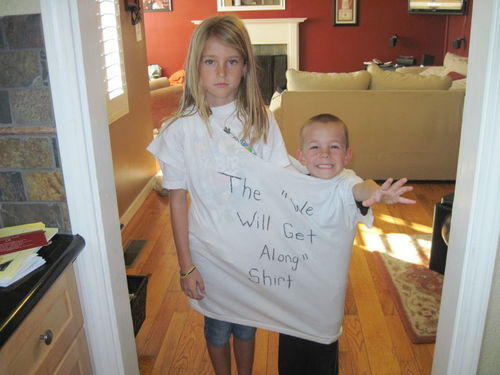 1. SIBLING SHIRTS – First off, has anyone seen these clever little “Get Along” sibling shirts yet? I’ve seen them all over Pinterest and thanks to NoWayGirl.com, I got a little bit more information on them, as well! I was an only child, so I must admit, I never had to deal with any of this before, but I did have a girlfriend whose Mother would make her and her brother “Hug It Out” whenever they had tiffs when we were all kids! The “Get Along” shirt has become the newer version of hugging it out! I love that it keeps these siblings in close quarters, even if for a few minutes, for them to realize that the other isn’t going to be going anywhere anytime soon! It’s so important to help our kids realize that the relationship with their sibling is one that will last a lifetime and is one of the most important relationships there will ever be. I just love this idea!
1. SIBLING SHIRTS – First off, has anyone seen these clever little “Get Along” sibling shirts yet? I’ve seen them all over Pinterest and thanks to NoWayGirl.com, I got a little bit more information on them, as well! I was an only child, so I must admit, I never had to deal with any of this before, but I did have a girlfriend whose Mother would make her and her brother “Hug It Out” whenever they had tiffs when we were all kids! The “Get Along” shirt has become the newer version of hugging it out! I love that it keeps these siblings in close quarters, even if for a few minutes, for them to realize that the other isn’t going to be going anywhere anytime soon! It’s so important to help our kids realize that the relationship with their sibling is one that will last a lifetime and is one of the most important relationships there will ever be. I just love this idea!
2. TRAVELING SIBLING SPATS – Are the kiddos doing most of their fighting in the car? Feel like you have no control because you are busy making sure you’re not running off the road? How about trying this next time… Don’t scream, shout, or make a big fuss. Simply pull over, shut off the car, and wait it out! They’ll figure it out pretty quickly that things need to get resolved if they are going to get anywhere anytime soon! Once things quiet down, it will finally be your chance to get to the bottom of what is going on and to make it clear that the car isn’t moving until they figure out their problem. Undistracted!
3. STAY NEUTRAL! – Now this is important, Mommy’s! Don’t EVER pick sides. Think Switzerland! You don’t want to get into a bad habit of making them believe that someone is always ‘wrong’ and someone is always ‘right’. You don’t want your kids to embrace that kind of behavior, right? You may know EXACTLY what happened and you may very well believe that someone was definitely wrong, but there is always an underlying reason for their fight, too. Be the compassionate third-party for both of them and help them see that working it out together is the best scenario.
4. LET THEM WORK IT OUT ON THEIR OWN – Speaking of staying neutral and to compound on #3, make sure you encourage them to work it out on their own. One of the best ways to teach our children how to communicate effectively when they are having a disagreement with someone is to start the practice at home with their own sibling. And I’m pretty sure you don’t always want to be the guy in the middle, right?! It’s a great idea to engage them to communicate with each other and to express their feelings by asking them questions like “How do you guys think you should handle this?” or “Do you both need to take a break before talking it over with your sibling first?”. You want to establish that sometimes a small breather is a good way to gather your feelings before saying things you will regret and can’t take back.
5. STAY CALM – I know that even now when the fights are small and it usually involves a toy that my son saw her baby sister take (even though she doesn’t realize it’s not ‘hers’), things escalate pretty quickly and my son wants his toy back! NOW! And than my daughter yells. ALOT! And I’m stuck trying not to yell at both of them to JUST. STOP. IT. Wait… back to the advice on staying calm! 🙂 The best thing you can do in situations with young children is to simply stay calm and generally, when I distract one of the two from the issue at hand with a different toy, or a book, or asking them a question about their day, than BAM! Crisis averted. Because I stayed calm and didn’t completely lose it the second my kids did!
6. PHYSICAL FIGHTS = DISQUALIFICATION – One thing I’ve been working on establishing quickly in our home is that when it comes to physical fighting, we have a ZERO tolerance policy. Right now, we don’t really have any real physical altercations going on, but there eventually are small pushes here and there when someone feels they’ve been wronged. My 4-year-old definitely knows better and all it takes is a threat of going to his room immediately for him to straighten up his act quick, apologize, and move on. My 2-year-old on the other hand is just trying to hold her ground and every once in awhile, the shove comes out and you would think DEFCON 5 is here! Right now with her, she immediately gets picked up and sits in a chair close to me with stern warnings on no more hitting. She doesn’t quite get it, but she immediately knows she did something wrong and she won’t do it again. Establishing some type of routine early for your children on what happens if things actually come to blows is important. If they know there is a zero tolerance for that type of behavior, they will know to expect consequences immediately!
7. TAKING OBJECTS AWAY FROM EVERYONE – I have a few girlfriends who I’ve talked to a lot about this particular idea recently and so far, it seems to be working well. Don’t EVER let your kids prioritize objects over their siblings! For example, if my kids suddenly start fighting over the same toy (right now it tends to be the LeapPad!), they BOTH will end up losing the privilege of using it. I take it away and gone it goes! This might contradict #4 of letting them work it out on their own, but when it comes to physical objects that are starting to cause conflict in our home, it’s not worth it to let them fight it out and figure out a solution. Especially with younger children where they just don’t have those reasoning skills sharpened yet. If anything, I’ll let our son use the object when my daughter is napping, and my daughter can use it other times during the day because my son is old enough to realize that he had “his time” with it. Fingers crossed!
8. READ THE BOOKS! – Another great idea is to read books with them about fighting with their siblings and why it is never a good idea! Some of the ones I found that were highly recommended are as follows:
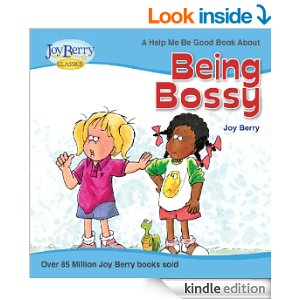 Help Me To Be Good About Being Bossy by Joy Berry
Help Me To Be Good About Being Bossy by Joy Berry
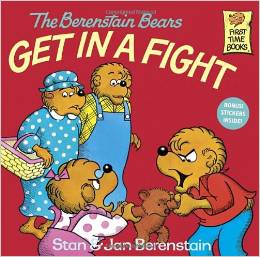 The Berenstain Bears Get In A Fight by Stan and Jan Berenstain
The Berenstain Bears Get In A Fight by Stan and Jan Berenstain
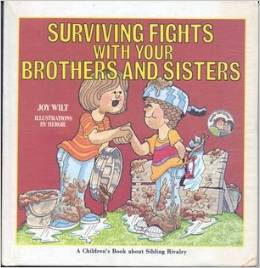 Surviving Fights With Your Brothers and Sisters by Joy Wilt Berry
Surviving Fights With Your Brothers and Sisters by Joy Wilt Berry
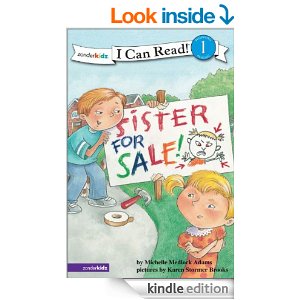 Sister For Sale: Biblical Values by Michelle Medlock Adams
Sister For Sale: Biblical Values by Michelle Medlock Adams
9. START WITH YOURSELF. ARE YOU FOLLOWING YOUR OWN ADVICE? – When it comes down to it, don’t you want to teach and model respect to your children yourself? Whether you are a single parent or in a great marriage, it’s always up to you if you model these things in your own life for them to see with their own two eyes. Have a hard time keeping your cool when someone cuts you off when you’re driving? Always have a need to “be right”? Your kids are going to see this and model their own behavior around this, at home and out in the world. And since it all starts at home with how they treat their siblings and the rest of the family, it’s the perfect place to model the behavior that you want them to emulate. That means saving the fights with your significant other for another time, or even working on your fighting skills, as well!
10. TIME TO TEACH – Finally, once things calm down and the spat is but a distant memory, it’s the perfect time to set boundaries with your little ones for future fights. Chat to them both about how they could handle it more effectively in the future. Do they think a new rule would help? Is there a way they could help each other not to lose their cool? What provokes them that their sibling can work on shutting down moving forward? These are the times of learning when you can communicate with your kids about what is and is not acceptable and when they can talk to each other about what bothers them.
There you go! I know that sibling spats are always a super stressful time, not only for the kids, but also for us parents! We don’t want to see our kids fight with each other and of course, we always want to help and make things A.O.K. But sometimes, by following some of these ways to calm the sibling spats, you may be teaching them more lifelong skills that they’ll need as they grow up, as well. Enjoy!
Do you have any special tricks to stop those inevitable sibling fights? If so, comment below and help the rest of us! 🙂






Leave a Reply